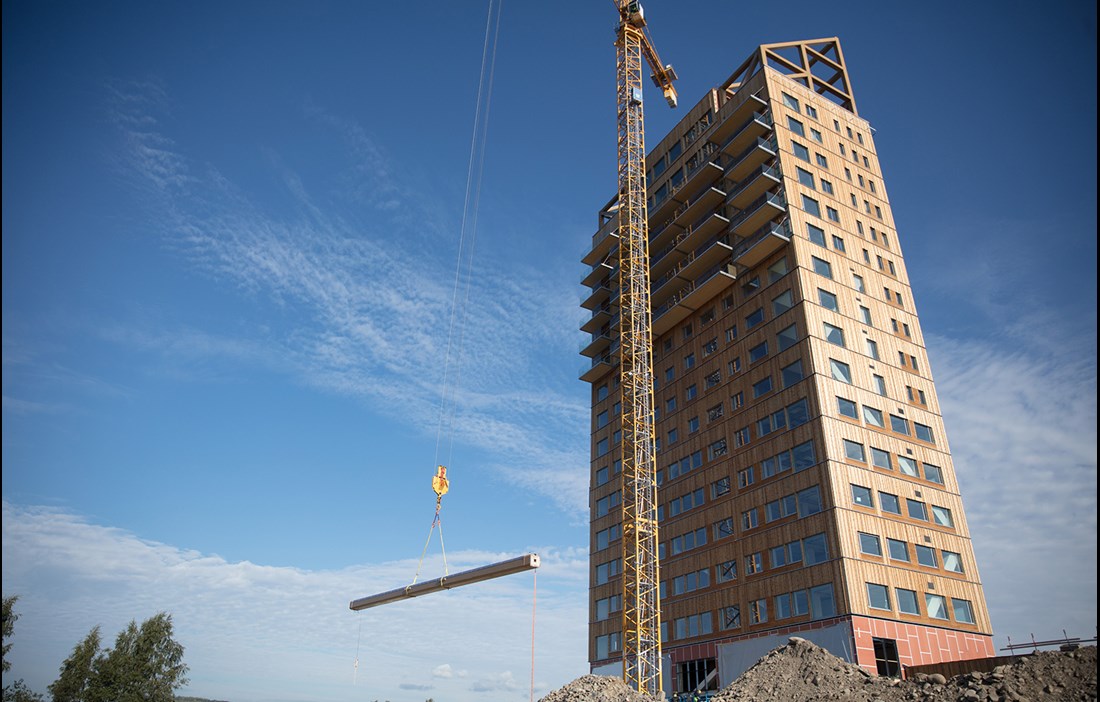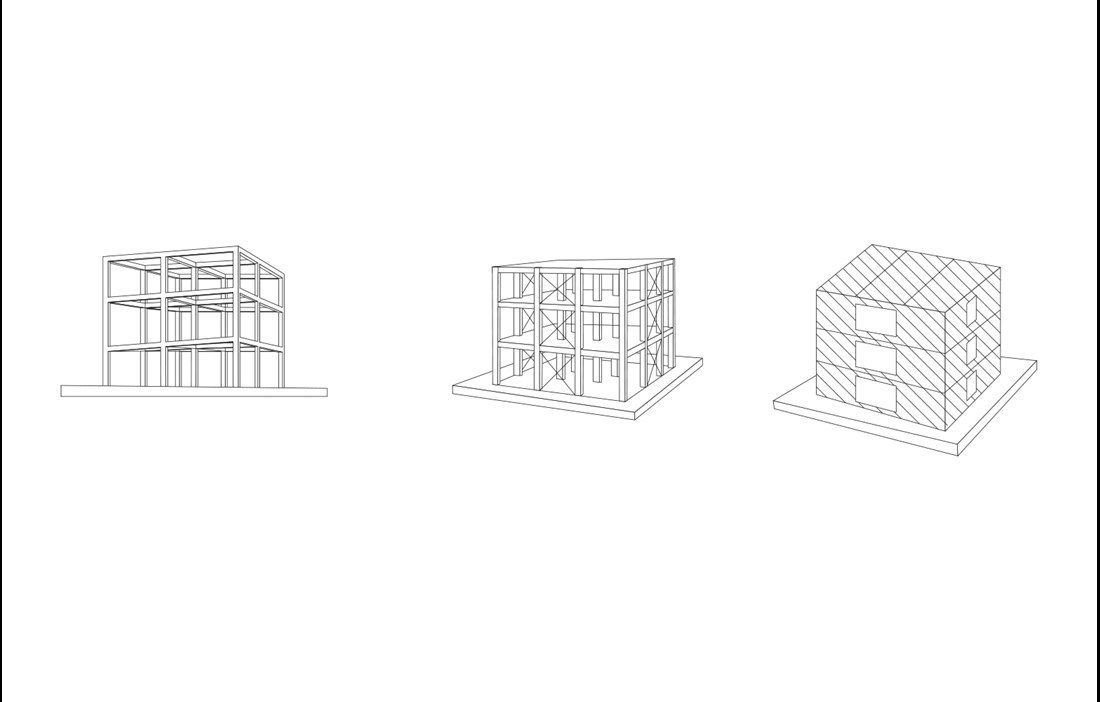More and more multi-storey buildings are being constructed in wood today, both in Sweden and internationally. There are many reasons why you might choose to go tall with wood – most of them rooted in the material’s environmental benefits, sustainability and, not least, aesthetics. The economics of it all can also play a crucial role, and here wooden structures have the advantage that they can be assembled quickly and easily thanks to their low self-weight.
A key issue when designing high-rise wooden buildings is the horizontal stiffness of the structure. Good horizontal stiffness limits movement caused by horizontal loads such as wind, for example. The most crucial factor in a building’s horizontal stiffness is the choice of stabilising system.
Stabilising multi-storey buildings
Lower wooden buildings of up to four or five storeys are usually stabilised by the diaphragm action in walls and floors, where panels (either wood-based or plasterboard) are nailed or screwed to a wooden structural frame to ensure sufficient load-bearing capacity and stiffness against horizontal loads.
With taller buildings (not skyscrapers) the following stabilisation methods are commonly used (see fig. 1):
a. Rigid joints
b. Braced frame
c. Diaphragm action.
Making the joints between posts and beams rigid is generally a simple and cheap method of stabilising a building. The method is used extensively for concrete carcasses and to some extent also with steel frames. However, this method tends to be unsuitable for wooden frames, because rigid joints are very difficult to achieve in this type of carcass.
Another way of ensuring the stability of a building is to add braces to the different levels of the structural frame, which in practice means creating vertical trusses. The material for the bracing is usually steel or wood or a combination of the two.
A third stabilisation method is to make use of the diaphragm action, whereby stability is achieved by the load-bearing parts of the frame – walls, floors and ceilings – taking up the lateral forces along their plane. In multi-storey buildings made entirely from wood, CLT is the most common sheet material. With hybrid solutions, a post-and-beam frame in wood can be combined with stabilising concrete slabs to good effect.
Planning uncertainties
Construction systems for tall buildings in steel began to flourish in the USA back in the mid-19th century. A few decades later, concrete also started being used to build high-rises. 2010 saw the opening of what is currently the world’s tallest building, Burj Khalifa in Dubai, UAE, a skyscraper that has concrete as its main construction material. It is 828 metres tall and has 164 floors. Construction systems for high-rises in steel and concrete have thus been around for a long time and have been improved over the years.
There are therefore relatively tried and tested methods for predicting horizontal stiffness, not least thanks to the fact that calculation models, usually calibrated through scientific experiments, began to be developed a very long time ago. Corresponding construction systems for wood have only been around for a few decades, which means that engineering experience, particularly with regard to stabilisation, is still in short supply.
Wooden structural frames often have low self-weight compared with other common construction materials, which makes the stabilisation of horizontal loads one of the key structural issues. In Sweden, wind load is the main cause of horizontal loads. In other parts of the world, earthquakes may be another cause. A building’s stabilisation system naturally has to meet the standard strength criteria, which require it not to fail under the stress of the greatest possible horizontal load.
The strength of the stabilisation system is, however, not the biggest challenge in a wooden multi-storey building. That honour goes to the stiffness of the stabilisation system, which can be a problem. With too little stiffness, the horizontal movements caused by wind can be large enough to cause damage to various parts of the building. In addition, acceleration in the lateral direction can become too much, causing a considerable drop in the comfort of residents. It should also be mentioned that the acceleration is significantly influenced by the building’s mass and damping.
As yet, we only have limited experience of tall wooden buildings, particularly those with more than eight or nine floors. Lateral stiffness is difficult to predict in wooden buildings, particularly because the connections between the various wooden components play such a critical role. There are a range of models for calculating the stiffness of certain types of connection, but they are often quite rough and therefore not entirely suitable for producing a reliable estimate. Damping is also surrounded by at least as much uncertainty. There is no doubt that more research is needed in order to obtain better knowledge about damping and joint stiffness.
Possible to use other materials
Wood is an excellent material for constructing buildings, but it has certain limitations – just like every other material. The tensile strength and axial stiffness of glulam (GL30c) is much lower than regular structural steel (S355) for example, at around 1/18 and 1/16 respectively. The presence of joints causes a further dramatic reduction in both the strength and stiffness of a wooden component. Let us look more closely at this. Take a very simple component, such as a diagonal brace in an abutted joint, as shown in fig. 1b. We will assume that the diagonal comprises a 6 metre long length of glulam with a cross-section of 200 x 200 millimetres and that the fixings in the two joints are inset plates and steel dowels. A simple calculation shows that the presence of the joints in the ends of the component reduces its strength and axial stiffness by a factor of two, compared with the original glulam component.
To achieve a stabilisation system with around the same stiffness as the diagonal glulam brace, all you would need is a hot finished hollow steel section of 70 x 70 millimetres, with a material thickness of 5 millimetres, and it would be just a third of the weight of the glulam brace. This example shows that choosing a stabilisation system in wood for tall buildings, where the requirement for horizontal stiffness is critical, can lead to very large cross-sectional dimensions that in some cases may be impractical. An alternative would be to use stabilising components in concrete, for example slabs or box units that can also serve as a lift shaft or stairwell. The advantage of concrete as a stabiliser is that its stiffness is around three times greater than wood, plus the loss of stiffness caused by any joints is small, particularly with site-cast concrete.
Stabilising Mjøstårnet
Around the world, architects are outdoing each other in creating the tallest wooden buildings. At the time of writing, the 18-storey mark has been reached with two apartment blocks where wood has been used as the main construction material. One of the blocks, Brock Commons, stands in Vancouver, Canada, at the University of British Columbia, UBC. It is 53 metres tall and was completed in 2017. The second, Mjøstårnet, is located in Brumunddal, Norway, and is expected to open on 1 March 2019. There are also plans in various stages of development to build even higher wooden buildings: a 19-storey cultural centre in Skellefteå, 24 storeys in Vienna, a 34-storey building on Västerbroplan in Stockholm and even an 80-storey, 300 meter high block in London.
We are going to take a closer look at Mjøstårnet, as an example of an apartment block with 18 storeys. It has a footprint of 17 × 37 square metres and rises to a height of 81 metres. The stabilisation system for this Norwegian block is almost entirely wood. The structure uses four vertical trusses in hugely dimensioned glulam as the stabilising elements in the walls (see fig. 2).
The floor system provides the horizontal stability, taking up the horizontal wind loads and channelling them into the adjacent vertical trusses (which in turn carry the load down to the ground). A floor system of the type “Trä8” has been used for floors 2–11, where LVL sheets take care of the diaphragm action along the floor’s plane. However, a concrete floor system has been chosen for floors 12–18. The switch from wood to concrete in the upper floors makes the building heavier towards the top. Since the building is narrow in one direction, the extra mass was necessary to reduce the effect of the wind and so meet the comfort requirement for residents. The concrete floor system also makes it slightly easier to achieve higher acoustic performance in the apartments. As well as taking some of the building’s self-weight, imposed load and snow load, the four corner posts are also part of the two vertical trusses that serve as stabilising elements when the wind hits the wider side of the building. The greatest axial forces therefore occur in these corner posts, whose cross-section measures 1,485 x 625 millimetres.
It can be worth comparing Mjøstårnet with Brock Commons, which Trä magazine wrote about in the first issue of this year.
Here they used two site-cast concrete cores to provide stability. These take up the horizontal loads from the CLT floor system and channel them down to the ground. This means that the posts in the Brock Commons building are not part of the stabilising system and therefore only need to cope with the vertical loads. The cross-sectional dimensions of the posts under the highest load on the lower floors are thus just 265 x 265 millimetres, and slightly less on the upper floors.
Text Roberto Crocetti























